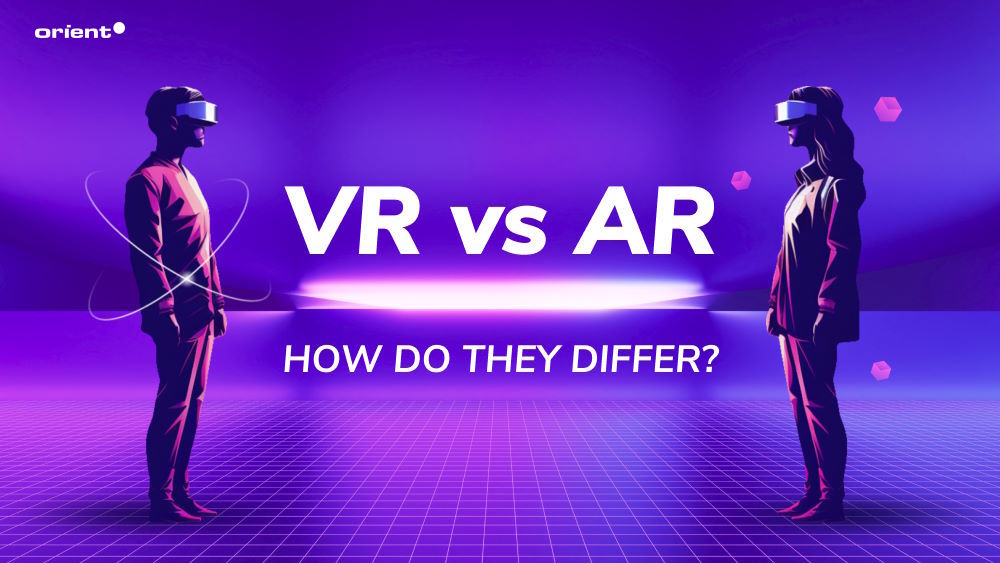Virtual vs. Augmented Reality: How Do They Differ?

Content Map
More chaptersWe are on the cusp of a new era in technology, where virtual reality (VR) and augmented reality (AR) are becoming more prevalent. These new realities allow users to experience digital environments and interact with them in ways that were once impossible. As developers continue to research and create new and innovative methods to use VR and AR, we can only imagine the possibilities that will be made available to us. So far, both VR and AR have been used for gaming and entertainment purposes, but there is no limit to what these two technologies can do.
However, augmented reality and virtual reality are frequently mixed up due to their similarities. Thus, we are going to delve into the definitions of each and look at how they differ to help you better understand these technologies and avoid misconceptions.
What Is Virtual Reality?
Virtual reality (VR) is a three-dimensional, computer-generated environment that a person can explore and interact with. VR technologies enable users to completely immerse themselves in a digital environment, whether a simulated world or a recreated version of the real world. This can be used for entertainment purposes, such as playing video games or watching movies, but it can also be used for more practical applications, such as training or education.
How Does Virtual Reality Work?
To create a virtual reality experience, the user wears a virtual reality headset that displays images on screens in front of their eyes. These screens create the illusion of depth so that the user feels like they are actually in the computer-generated world. Virtual reality headsets can also track the user’s movement so that they can move around in the virtual world. This adds to the sense of immersion, making it feel like you are really there.
Some virtual reality headsets include sensors that can track the user’s heart rate and other biometric data. This can be used to create a more immersive experience by adjusting the environment based on the user’s emotional state. VR technology is still in its early stage of development, but it is quickly evolving and becoming more sophisticated. It is likely that virtual reality can play a bigger role in our lives in the future.
What Is Augmented Reality?
Augmented reality, or simply AR, is an interactive experience of a real-world environment where the objects residing in the physical world are augmented by computer-generated perceptual information. In other words, AR technologies enhance one’s current perception of reality by adding virtual objects to it. AR has much potential to change how we interact with both our digital and physical worlds.
Augmented reality adds an artificial layer to the real world. This layer can be interactive or non-interactive, and it is usually displayed using a head-mounted display (HMD). While augmented reality was originally used for military purposes, it is now commonly used in entertainment, education, and business. One of the most typical examples of AR apps is Pokémon GO.
How Does Augmented Reality Work?
Augmented reality works by superimposing digital information on top of the real world. This can be done using a head-mounted display or by using a mobile device such as a mobile phone or tablet. When using a head-mounted display, the augmented reality device is fitted onto your head, and it projects the digital information directly in front of your eyes. When using a mobile device, the digital data is displayed on the screen, and it is overlaid on top of the real world that you can see through the device’s camera.
Similarities Between Virtual Reality and Augmented Reality
There are a few similarities between virtual reality and augmented reality. For these affinities, AR and VR are often mistaken for each other:
- Both virtual reality and augmented reality involve the addition of digital info to the real world. In virtual reality, this information is used to create a completely simulated environment, while in augmented reality, this information is used to add new layers of interaction to the real world.
- Both virtual reality and augmented reality use head-mounted displays or mobile devices to display digital information.
- Both technologies are constantly evolving and becoming more sophisticated.
Distinguish the Differences Between Virtual Reality and Augmented Reality
Virtual reality and augmented reality are similar for the most part, but there are some critical differences between the two. Here are eight of the most important distinctions:
- Location: VR takes place in a completely virtual environment, while AR takes place in the real world and augments it with virtual elements. Or, more simply, VR is an entirely digital experience, while AR is a combination of the real and digital worlds but more into the physical world.
- Immersion: VR provides a more immersive experience because users are typically enclosed in a headset that blocks out all real-world stimuli. AR doesn’t require as much immersion because AR users can still see and interact with their surroundings.
- Field of View: VR offers a broader field of view than AR since augmented reality requires that digital elements be inserted into the user’s real-world view.
- Resolution: VR typically has a higher resolution than AR since AR elements must be viewable in the user’s real-world environment.
- Graphics: VR graphics are typically more realistic and immersive than AR graphics, which are often less detailed and less realistic.
- Tracking: VR tracking is more accurate and responsive than AR tracking, which can be affected by environmental factors like lighting and obstructions.
- Usability: VR is typically more user-friendly and intuitive than AR, which can require more of a learning curve.
- Price: VR headsets are more expensive than AR headsets.
AR and VR vs. MR – A Brief Distinction
Not only are AR and VR mixed up for each other but sometimes also mistaken with mixed reality (MR).
So, What Is Mixed Reality?
Mixed reality or MR is an environment that seamlessly blends the real world with the virtual world. MR allows users to interact with virtual objects in the same way that they would interact with real-world objects. This means that users can touch, pick up, and move virtual objects around the same way they would do with real-world objects. MR is also known as hybrid reality or merged reality.
How Mixed Reality Differs from VR and AR
It is important to note that AR, VR, and mixed reality are all different technologies. VR provides an entirely virtual environment, while AR augments the real world with virtual elements. MR is a combination of the two technologies, and it allows users to interact with both the real and virtual worlds simultaneously. Mixed reality typically has a higher resolution than AR because it requires that digital elements be inserted into the user’s real-world view. Mixed reality headsets are also more expensive than AR headsets.
Conclusion

In brief, virtual reality and augmented reality are similar for the most part, but there are some critical differences between the two technologies. It is essential to understand the distinctions between AR and VR so that you can choose the right technology for your needs. Moreover, through this article, we want to help you be aware of the mixed reality, which is another common misconception about the two technologies we are talking about.







